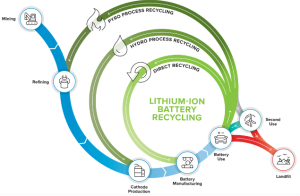Currently, lithium batteries cannot be recycled 100%. Although modern technology can recycle more than 90% of cobalt and lithium, the recycling efficiency for other elements such as nickel and aluminum is lower, and technical costs and safety issues are also limiting factors.
The Necessity of Recycling Lithium Batteries
Globally, over 500,000 tons of spent lithium batteries are generated every year. If these batteries are discarded without treatment, not only is a large amount of precious metals and rare elements wasted, but it can also lead to severe environmental pollution. Statistics show that recycling lithium batteries can recover over 90% of useful metals such as cobalt and lithium, which not only reduces dependence on raw mining but also significantly lowers the environmental cost of producing new batteries.
Tesla has achieved a material recycling rate of up to 92% in its battery recycling program, significantly reducing the cost and environmental impact of producing new batteries. “Resource recycling is our common responsibility and challenge,” said Elon Musk, the founder of Tesla, describing the importance of lithium battery recycling.

How to Process Spent Lithium Batteries
The process for handling spent lithium batteries typically includes collection, sorting, pretreatment, and deep recycling steps.
Effective collection is the first step in processing spent lithium batteries. Many countries have established dedicated recycling stations and bins to facilitate the proper disposal of lithium batteries by consumers and businesses. In Germany, over 90% of electronics retailers offer free battery recycling services.
Different types of lithium batteries, such as lithium-ion and lithium polymer batteries, require different processing and recycling technologies. Accurate sorting can reduce errors and safety risks during the processing and simultaneously increase the purity and value of the recycled materials.
Pretreatment includes discharging the batteries, dismantling them, and conducting preliminary chemical treatment. The purpose of this step is to safely transform the batteries into a state that is easier to handle and to separate recyclable materials as much as possible. Discharging is a particularly important step because batteries that have not been discharged may undergo dangerous chemical reactions during dismantling.
In the deep recycling phase, valuable metals and other reusable materials are extracted from the batteries through advanced chemical and physical processes. Up to 95% of cobalt and lithium can be recovered from waste batteries through hydrothermal treatment and electrochemical methods.
Why 100% Recycling is Difficult to Achieve
The main challenges include technical difficulties, economic costs, and safety risks. Current recycling technologies are not yet able to completely recover all valuable materials from spent lithium batteries.
Technical complexity is a significant factor. Lithium batteries are composed of a variety of compounds and alloys, making it difficult for a single recycling process to be suitable for all types of batteries. Current recycling technologies primarily target major value elements like cobalt and lithium, while the recycling efficiency for other elements such as nickel and aluminum is relatively low. Although existing technologies can recover about 90% of cobalt from lithium batteries, the recovery rate for lithium is only about 50%.
Economic costs are also a barrier to achieving 100% recycling. Unless the value of the recovered materials can cover these costs, insufficient economic benefits may make recycling projects unsustainable. Due to market price fluctuations, the prices of recovered raw materials are unstable, increasing the risk for investors.
Lithium batteries may undergo thermal runaway or explode when damaged or improperly handled, posing additional difficulties and safety risks to the recycling effort.
